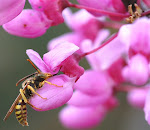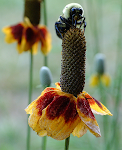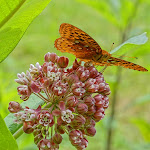Happy Spring, bee people. After a long winter with extraordinary snowfall (50+ inches in central VA is very unusual in these warmer climate years), yesterday I went back into the hives, to see how the ladies fared.
The answer is mixed: one hive, the blue one, is doing splendidly. Lots of honey from last season, lots of brood, lots of workers. I had checked in three weeks ago, before leaving on a big trip, and came home intending to reverse all the hive boxes (swapping bottom with top boxes keeps a production chain going by putting the empty frames back on top for Queen Elizabeth to fill). This I did.
My only concern about Elizabeth was she has more than the usual number of drone cells. Not so many that I think workers are laying (i.e. no queen present), but more than the usual distribution. I seem to remember that last year, prior to swarming, there were a lot of drone cells. Maybe Eliz was feeling crowded and the wheels are now in motion. This time around I'd like to split her hive if it comes to it, capturing bees before they leave. Also I might need to because I fear I am losing my second hive...
The green hive, Kathryn's, I was worried about last fall. She had a heavy varroa mite infestation and I'd seen crippled wing disease. Her worker numbers were WAY down after the winter. Three weeks ago I had given her a frame of Elizabeth's brood, hoping to boost numbers.
However, when I opened her up yesterday I saw: very small amount of brood, a spotty brood pattern, holes in some of the brood caps, and dead rotting larvae inside cells. All of this sounds like Foulbrood, a perfectly horrible disease that not only kills off the hive, but requires the keeper to burn everything because the disease is spread by spores which contaminate the hive boxes and frames.
See what I mean about the pain of beekeeping? I've put a call out to my beekeeping mentors to confirm the diagnosis.
*Sigh*. Such a bummer.
Beekeeping Tips On Fixing A Queenless Hive
1 week ago




